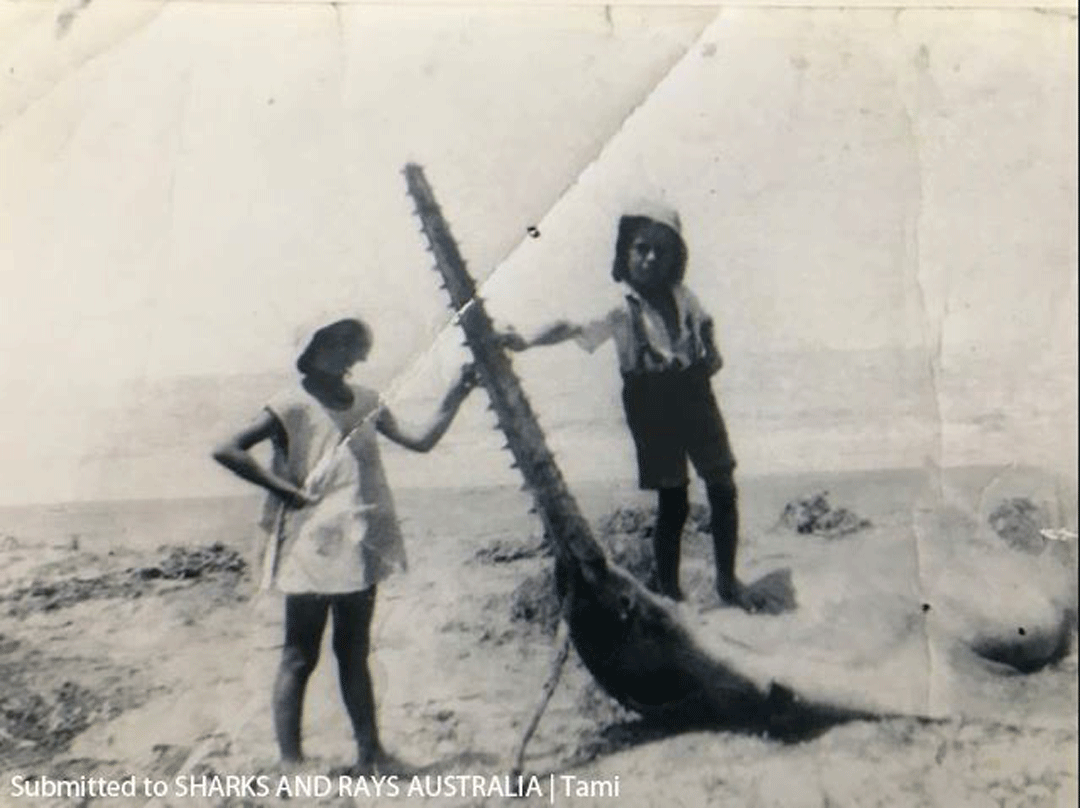You saw sawfish!
Hundreds of citizen science sightings reveal opportunities to protect Australia’s four iconic sawfish species
- New hotspots for green sawfish in Weipa and Karratha.
- A sawfish nursery in the Brisbane River until about 1950.
- Evidence that sawfish have not completely disappeared from NSW waters, with a Newcastle sighting.
- Juvenile sawfish reported down the WA coast.
- More action needed in Queensland as only one species reported south of Cooktown.
- A new call to action to step up conservation and assess the impact of net-free zones in Weipa and Queensland’s east coast.
- And keep reporting your sightings. Together we can save sawfish.

Photo © Tami | Sharks and Rays Australia
In January 2019 researchers from Sharks and Rays Australia called on Australians to report sightings of sawfish: in the wild; in old photos and on the trophy wall. Hundreds of Australians responded.
“The public has generated a completely new data set on the historic and current distributions of these rare and endangered species,” says SOSF Project Leader Dr Barbara Wueringer, the Principal Scientist of Sharks And Rays Australia (SARA).
“Sawfish are remarkable hunters. They hang around in the mud, detect the electric fields of passing prey, and slice and dice them with their saw-like snouts ready for dinner.”

The team have received over 500 submissions from people around Australia who contributed their photographs, specimens and stories of sawfish, the most endangered of all sharks and rays globally. Submissions included verified sightings of live fish, photographs from family albums, and additionally 140 sawfish specimens donated to the research project.
Queensland had 42 per cent of sightings and reports. This includes sightings of narrow sawfish confirmed south of Cooktown. However, data from the Southern Gulf of Carpentaria is scarce.
Western Australia had 40 per cent of submissions. Recent freshwater and dwarf sawfish reports were limited to northwest of King Sound. However, green sawfish appear to be more widely distributed, with many sightings of groups of juveniles reported as far south as Carnarvon.

Map of Australia. Image © Google Maps | Google
Only four per cent of sightings and reports came from New South Wales, but they were significant. They included a report of a 2002 accidental capture and release of a green sawfish at Hawke’s Nest and a possible sighting near Newcastle in 2018. The last confirmed green sawfish had been at Tweed Heads in 1969. Further confirmed sightings could lead to the protection of the species in NSW waters.
14 per cent of sightings were from the Northern Territory, and a couple of lookalikes were spotted in Victoria.
Most sightings occurred around human population centres such as Darwin (NT) and Weipa (QLD), or the coastal towns of the Pilbara region (WA) – areas that typically have nets for fishing or protection from sharks.
These nets can be deadly to sawfish. So, researchers need to know if higher numbers of sawfish are found inside net-free zones that have been established near Weipa and Darwin.
They’re calling on commercial fishers, particularly in Queensland, who may visit these remote waters to lend a hand and report their sightings.
Forty years ago, sawfish were regularly seen off Sydney and the east coast, and Perth and up the west coast. Today they’re rarely seen outside of the Gulf of Carpentaria, NT and the Kimberley.

Photo © Jackson | Sharks and Rays Australia
“Your sightings, no matter how long ago they happened, will help us work out how many sawfish there used to be, how many remain, and how we can help them recover,” says Barbara.
People can get involved and report their sightings here.
“We’re working with local Indigenous Ranger groups, fishers, and landowners, and with scientists from around the world.
SARA is based in Cairns. Their research is supported by the Save Our Seas Foundation (based in Geneva), a Queensland Citizen Science Grant from the Queensland Government, and the US-based Shark Conservation Fund.
All sightings generated by the project will be shared with Team Sawfish at Murdoch University, WA and sawfish researchers from Charles Darwin University, NT.
